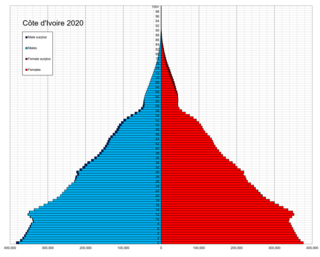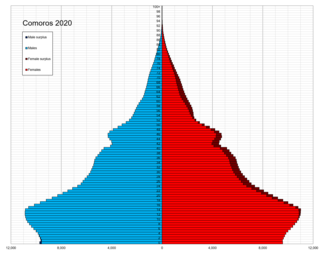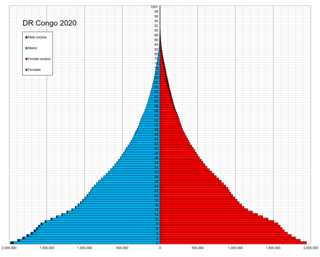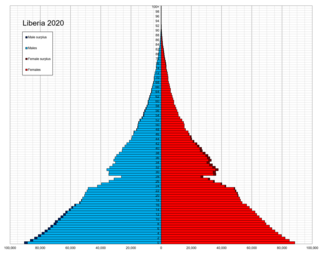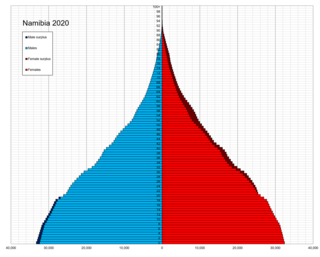| Demographics of Tanzania | |
|---|---|
 Population pyramid of Tanzania in 2020 | |
| Population | 63,852,892 |
| Growth rate | 2.78% (2022 est.) |
| Birth rate | 33.3 births/1,000 population |
| Death rate | 5.09 deaths/1,000 population |
| Life expectancy | 70.19 years |
| • male | 68.42 years |
| • female | 72.02 years |
| Fertility rate | 4.39 children |
| Infant mortality rate | 30.87 deaths/1,000 live births |
| Net migration rate | -0.41 migrant(s)/1,000 population |
| Sex ratio | |
| Total | 1 male(s)/female (2022 est.) |
| At birth | 1.03 male(s)/female |
| Nationality | |
| Nationality | Tanzanian |
| Language | |
| Official | Kiswahili or Swahili, English |
| Part of a series on the |
| Culture of Tanzania |
|---|
 |
| People |
| Languages |
| Religion |
| Literature |
| Music |
| Sport |
Demographic features of the population of Tanzania include population density, ethnicity, education level, health of the populace, economic status, religious affiliations, and other aspects of the population.
Contents
- Population
- Structure of the population
- Vital statistics
- Life expectancy
- Population numbers
- Fertility and Births (Demographic and Health Surveys)
- Total fertility rate in Tanzania
- Other demographic statistics
- Population 2
- Religions
- Age structure
- Median age
- Birth rate
- Death rate
- Total fertility rate
- Population growth rate
- Mother's mean age at first birth
- Contraceptive prevalence rate
- Net migration rate
- Dependency ratios
- Urbanization
- Major infectious diseases
- Ethnic groups
- Sex ratio
- Life expectancy at birth
- HIV/AIDS
- Languages
- Education expenditures
- Literacy
- School life expectancy (primary to tertiary education)
- Unemployment, youth ages 15-24
- Religions 2
- See also
- References
The population distribution in Tanzania is extremely uneven. Most people live on the northern border or the eastern coast, with much of the remainder of the country being sparsely populated. [1] : 1252 Density varies from 12 per square kilometre (31/sq mi) in the Katavi Region to 3,133 per square kilometre (8,110/sq mi) in Dar es Salaam. [2] : 6 Approximately 70 percent of the population is rural, although this percentage has been declining since at least 1967. [3] Dar es Salaam is the de facto capital and largest city. Dodoma, located in the centre of Tanzania, is the de jure capital, although action to move government buildings to Dodoma has stalled.
The population consists of about 125 ethnic groups. [4] The Sukuma, Nyamwezi, Chagga, and Haya peoples have more than 1 million members each. [5] : 4
Over 100 languages are spoken in Tanzania, making it the most linguistically diverse country in East Africa. [6] Among the languages spoken in Tanzania are all four of Africa's language families: Bantu, Cushitic, Nilotic, and Khoisan. [6] Swahili and English are Tanzania's official languages. [6] Swahili belongs to the Bantu branch of the Niger-Congo family. [7] The Sandawe people speak a language that may be related to the Khoe languages of Botswana and Namibia, while the language of the Hadzabe people, although it has similar click consonants, is arguably a language isolate. [8] The language of the Iraqw people is Cushitic. [9] Other languages are Indian languages and Portuguese (spoken by Goans and Mozambicans).
Although much of Zanzibar's native population came from the mainland, one group known as Shirazis traces its origins to the island's early Persian settlers. [ citation needed ] Non-Africans residing on the mainland and Zanzibar account for 1 percent of the total population. The Asian community include Hindus, Sikhs, Shi'a and Sunni Muslims, Parsis, and Goans, has declined by 50 percent in the 2000s and early 2010s to 50,000 on the mainland and 4,000 on Zanzibar. An estimated 70,000 Arabs and 20,000 Europeans (90 percent of which are from the British diaspora) reside in Tanzania. Over 100,000 people living in Tanzania are of Asian or European ancestry. [10]
Based on 1999–2003 data, over 74,000 Tanzanian-born people were living in Organisation for Economic Co-operation and Development countries, with 32,630 residing in the United Kingdom; 19,960 in Canada; 12,225 in the United States; 1,714 in Australia; 1,180 in the Netherlands; and 1,012 in Sweden. [11]











